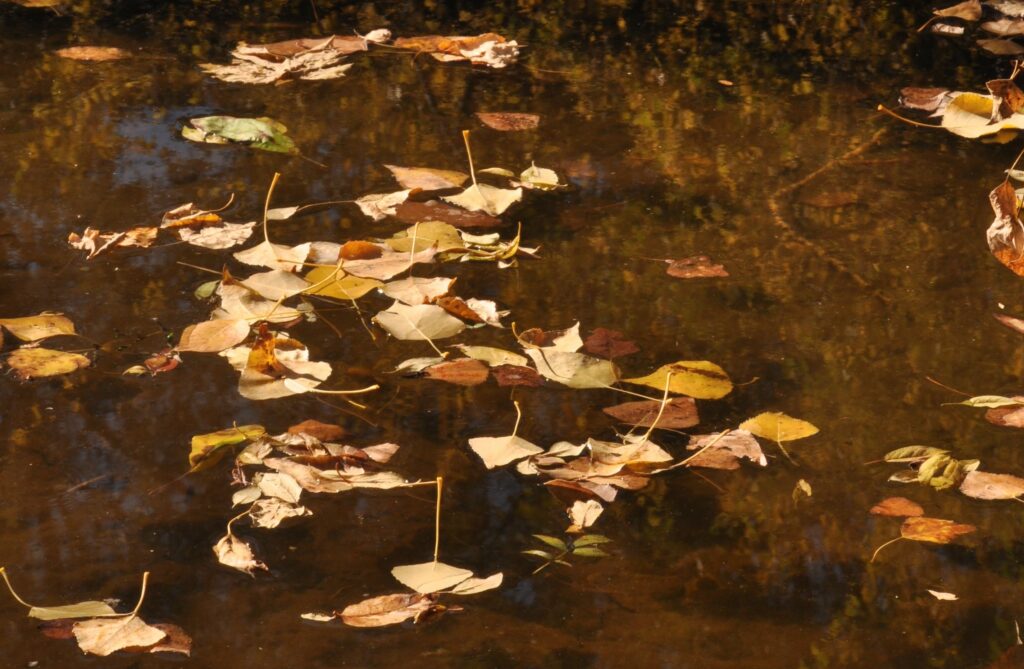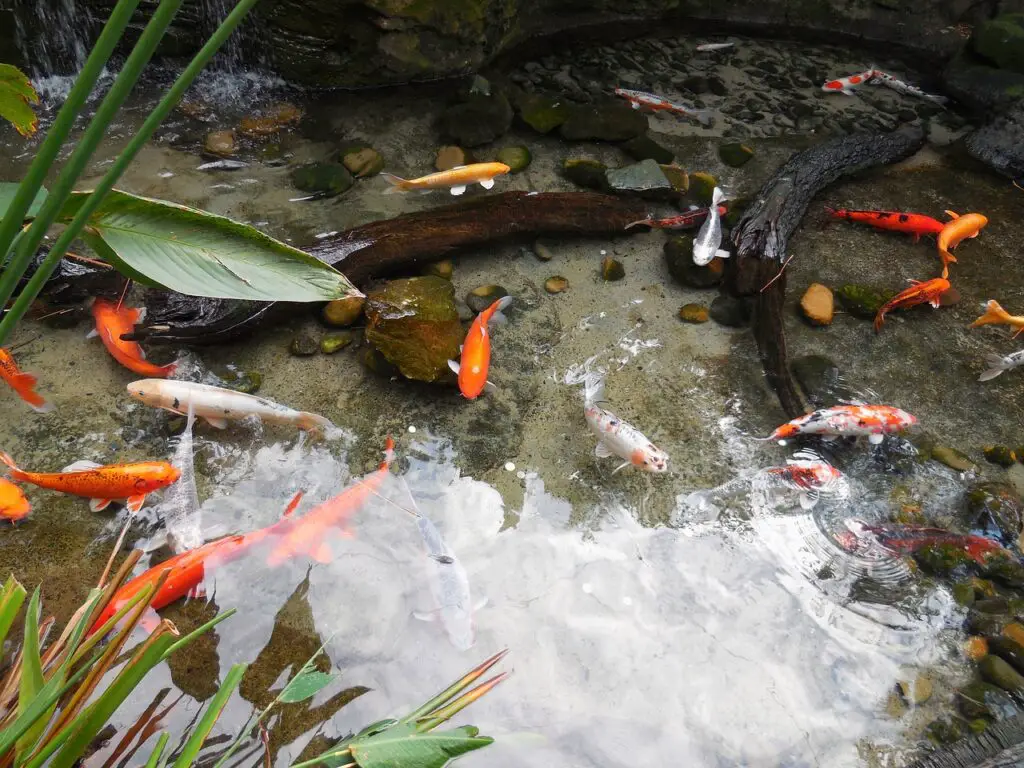From removing debris, cleaning your pump and filter, to taking care of your fish, this article provides the key steps to winterize your pond.
At the end of the article you can find my recommended products that will help you winterize your pond.
The links provided are Amazon affiliate links, meaning that if you decide to make a purchase through them, I may earn a small comission.
Netting and Debris Removal
During the year, organic matter is constantly accumulating in your pond (especially in fall!). Be it dead plant matter, fish faeces, uneaten food – you name it! As in warmer months it usually shouldn’t be a problem, as the nitrifying bacteria can do their job well in those temperatures, it can change quickly as soon as the temperatures drop! It’s best to remove as much organic material as possible to avoid the buildup of toxic substances in the water.
Here are some simple tips for netting and debris removal:
Installing Pond Netting
Before the leaves start falling from the trees, consider installing pond netting over your pond. Netting acts as a protective barrier, preventing leaves from entering the pond and accumulating at the bottom. This makes reducing the organic matter much easier and saves you from a messy cleanup later on. Once all the leaves have fallen, simply roll up the net, discard the leaves, and store the net for future use.
Clearing out Fallen Leaves and Debris
If you didn’t install netting, you’ll likely have some leaves and debris swimming in your pond. Using a pond net/ skimmer, like this one, gently scoop out the fallen leaves, twigs and debris both – floating and from the bottom of the pond. This will help prevent the accumulation of organic matter that can decay and negatively impact water quality during winter.

Pump and Filter Maintenance for pond winterizing
Disconnecting and Cleaning the Pump and Filter
Before winter sets in, disconnect your pump and filter from the electrical supply. Thoroughly clean both components to remove any debris or buildup that may have accumulated. Follow the manufacturer’s instructions for cleaning to ensure proper care and avoid damage.
Storing the Pump and Filter in a Warm Location
To protect your pump and filter from freezing temperatures, store them in a warm place such as a garage or basement. Cold temperatures can cause damage to the internal components, so providing them with a suitable storage environment will extend their lifespan and prevent costly repairs.
A good practice is to even store your pump in e.g. a bucket of water to prevent the seals from cracking and becoming leaky.
Draining Water from Plumbing to Prevent Freezing
To avoid potential damage from frozen water, drain the water from the plumbing connected to your pump and filter in case you leave them in the pond. This step will prevent the expansion of ice, which can lead to cracked pipes and other plumbing issues. Follow the manufacturer’s guidelines or seek professional assistance if you’re unsure how to properly drain the plumbing system.
UV clarifier
If you are using a UV clarifier, make sure you take care of it too! Disconnect and clean it with a soft cloth. Check how long the bulb was used and exchange it if necessary. It loses its potency with the time.
Trimming and Preparing Plants for winter
Taking care of your pond’s plants is an important aspect of pond maintenance, especially as winter approaches. Here are some simple tips for trimming and preparing your plants:
Trimming Dead Foliage and Removing Tropical Plants
As the season transitions, trim any dead foliage from your plants. The same as with removing debris – this helps remove excessive organic debris that could decompose in the water and affect water quality.
Protecting Hardy Plants by Moving Them to the Bottom of the Pond
Hardy plants can survive the winter if properly protected. Trim hardy water lilies to about two inches above the crown and move them to the deeper parts of the pond, preferably at least half a metre deep. This protects them from freezing temperatures and helps maintain their health during the dormant period.
Proper Care and Storage of Plants During Winter
If you have potted plants, consider moving them to a sheltered location, such as a garage or basement, to protect them from extreme cold. Keep the pots moist but avoid overwatering. For plants that remain in the pond, monitor their condition and make sure they are not disturbed by ice formation or other factors that may cause damage.
Aeration and Oxygenation when winterizing your pond
Adding Aeration Equipment for Oxygenation
Installing an aeration system, such as a pond aerator or air pump, helps with gas exchange, including introducing oxygen into the water. Oxygen is vital for fish and beneficial bacteria, especially during winter when oxygen levels may decrease. The bubbling action of an aerator also helps circulate the water, preventing stagnation and reducing the risk of harmful algae growth.
Preventing Ice Formation with a Pond Heater or De-icer
In colder regions, ice formation can be a concern. To prevent the pond from completely freezing, consider using a pond heater or de-icer. These devices help maintain an opening in the ice, allowing oxygen to enter and harmful gases to escape. This is essential for the survival of fish and other aquatic organisms during the winter months.
In addition, it’s important to monitor the surface of your pond during winter. If a solid layer of ice forms, make sure to break through it to maintain a hole in the ice. This hole allows for gas exchange, ensuring the proper exchange of oxygen and carbon dioxide, and helps maintain a healthy balance in the pond.
Fish Care and Feeding during winter
Taking care of your pond fish is essential for their health and well-being. Here are some important tips for beginners:
Monitoring Fish Health and Feeding Practices
Regularly observe your fish for any signs of illness or distress. Look for abnormal swimming patterns, changes in appetite, or visible signs of disease. If you notice any issues, consult a specialist for guidance. Additionally, avoid overfeeding your fish, as it can lead to poor water quality and health problems.
Before winter settles, you may want to boost your fish’s immune system.
Switching to Cold Water Fish Food
As the water temperature drops, you may need to switch to a cold water fish food specially formulated for lower temperatures. Cold water fish food is easier for fish to digest during colder months and provides the necessary nutrients to support their immune system and overall health.
Adjusting Feeding Frequency Based on Water Temperature
As the temperature decreases, the metabolism of fish slows down, and their feeding requirements change. Adjust the frequency of feedings accordingly. When the water temperature falls below 10 degrees Celcius (50 degrees Fahrenheit), feed your fish sparingly, only offering what they can consume in a few minutes. When the temperature drops below 5 degrees Celcius (40 degrees Fahrenheit), it’s best to stop feeding altogether until spring.
Bacteria Treatment when winterizing your pond
Maintaining water clarity and quality in your pond is crucial, even during the winter months. Here’s what beginners need to know about bacteria treatment:
Using Cold Water Beneficial Bacteria
Cold water beneficial bacteria are bacteria strains ready to work in lower water temperatures, such as those experienced during winter. These bacteria are different from nitrifying bacteria typically used for biological filtration, as our usual nitrifying bacteria stop doing their job in temperatures below 12-13 degrees Celsius (55 degrees Fahrenheit). The robust low-temp bacteria help break down organic debris and waste, reducing the risk of water pollution and maintaining a healthier environment for your fish and plants.
Benefits of Bacteria Treatment in Winter
Bacteria treatment is just as important during winter as it is in warmer seasons. While the metabolic activity of fish and plants decreases in colder temperatures, organic matter still accumulates in the pond, moreover, we are most likely not able to get everything out of the pond. Cold water beneficial bacteria continue to break down this organic debris, preventing the build-up of harmful compounds and maintaining water clarity.
Choosing the Right Bacteria Product
When selecting a bacteria treatment product, opt for one specifically formulated for cold water conditions. Look for products that contain concentrated strains of cold water beneficial bacteria, capable of functioning effectively even in temperatures as low as freezing, e.g. like this one.
Tools and Equipment for Winter Pond Care
When it comes to pond maintenance and winterization, having the right tools is essential. Here are a few must-have items:
Cleaning the pond:
- Pond Net: Use a pond net to prevent leaves and debris from accumulating in your pond during fall. This makes cleanup much easier.
- Pond Skimmer Net: A long-handled pond skimmer net is perfect for removing leaves and debris that may have fallen into the pond.
For your fish:
- Soft fish net: avoid hurting your fish using a net with a rough mesh. I’m a big fan of silicone nets! They are very gentle. Make sure to choose the right size for your fish.
- Easily digestible winter koi/ goldfish feed
Keeping the pond ice-free and aerated:
- Aerator (already together with air stones and “one way” valves)
- Deicer: Stone-like deicer from Tetra
- Pond heater: make sure to choose the right size for your pond. You can also create a small corner, where water is warmer, so fish can choose where they want to be.
- Cold temperatures bacteria (very concentrated): 4l (1 gal) for big ponds (the whole canister treats 300 000l or 80 000 gal) or 230 ml (8 oz) for smaller ponds (the whole bottle treats almost 20 000 liters or 5 000 gal). Keep in mind you may need to treat the pond with bacteria several times during winter.
Having the right tools and resources at your disposal simplifies pond maintenance and ensures a healthy and thriving pond throughout the winter months.
Winterizing your pond doesn’t have to be daunting. With these simple maintenance tips, you’ll ensure a healthy and thriving pond throughout the colder months.



